|
Research Title/ Field
|
Article (Abstract)
|
Download
|
|
Effect of Whole-cotton seed supplementation on
growth performance and
haematological properties of
Djallonke sheep.
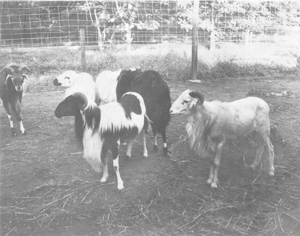
|
Original Research, A24
Ansah, T., Teye, G.A. and Addah W.
Online J. Anim. Feed Res., 1(5): 155-159, 2011.
ABSTRACT: An 8-week feeding trial was carried out to investigate the effect of whole-cotton seed (WCS) supplementation on the growth performance and some blood constituents of Djallonke sheep fed rice straw. A total of 12 sheep with an initial weight of 13.7 ± 0.20 kg were randomly assigned to one of three treatments (four animals per treatment). The treatments consisted of no supplementation (T0) and supplementation with 200 g /head/d (T1) or 400 g/head/d (T2) on as fed basis. Feed intake, growth performance and some haematogical parameters (haemoglobin [Hb], packed cell volume [PCV], white blood cells [WBC], red blood cells [RBC]) were measured. Differential leukocyte (lymphocytes, neutriphils, eosinophils, monocytes and basophils) counts were also determined. Intake of basal diet was higher (P<0.05) for sheep supplemented with 400 g/head/d than for those receiving 200 g/head/d and WCS intake was higher (P<0.05) for sheep fed T2 than for those fed the T1 diet. Feeding the basal diet only resulted in weight loss and high mortalities. Haemoglobin concentration, PCV, and WBC and RBC counts increased with supplementation but the difference between T1 and T2 for these measurements was not significant (P>0.05). Eosinophilia increased (P>0.05) with increasing level of supplementation. This study suggests that WCS is a good source of rumen degradable protein and can help reduce the decline in growth of sheep especially in the dry season.
Keywords: Whole cotton seed, rumen degradable protein, Eosinophiles.
|
 |
|
Growth performance and economy of replacing maize with combinations of brewers’ grains, jack bean and cassava root meal in broiler finisher rations.
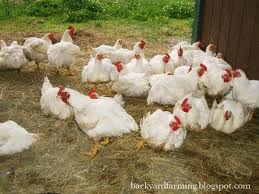
|
Original Research, A25
Uchegbu, M.C., Herbert, U., Ogbuewu, I.P., Nwaodu, C.H., Esonu, B.O. and Udedibie A.B.I.
Online J. Anim. Feed Res., 1(5): 160-164, 2011.
ABSTRACT: This study was done to determine the effect of complete replacement of maize with maize/sorghum-based brewers’ dried grains (MSBDG), jackbean (JB) and cassava root meal (CRM) on performance of finisher broilers and the feed cost implication of using these test materials as the major energy sources. Four experimental diets T1, T2, T3 and T4 were formulated to contain maize, MSBDG, JB and CRM in the following proportions 60, 0, 0, 0%; 0, 20, 15, 25%; 0, 20, 20, 20%, and 0, 20, 25, 15% respectively. Other ingredients were the same for the four diets. One hundred and sixty eight (168) 4-week-old Hubbard broilers were divided into 4 treatment groups of 42 birds each; and each group subdivided into 3 replicates of 14 birds per replicate. Each treatment group was randomly assigned to an experimental diet in a completely randomized design (CRD) experiment. The feed intake of T1, T2 and T4 birds were similar (p>0.05) but lower (p<0.05) than that of T3 birds. There was no significant (P>0.05) difference in daily weight gain between T1 (1.70g) and T2 (1.55g) birds. The feed conversion ratio of T1 birds was better (p<0.05) than T2, T3 and T4 birds. The feed cost of N195.58 for T4 required to produce 1kg meat was lower than the cost of N214.50 required for meat production in T1. Generally, the MSBDG/JB/CRM feeds produced 1kg meat at costs 6.17%, 3.71% and 8.82% for T2, T3 and T4 lower than the T1 diet.
Keywords: Broilers, feed ingredient combinations, performance
|
 |
|
Groundnut oil improves tenderness, juiciness and consistency of beef sausages
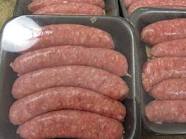
|
Original Research, A26
TEYE, M., TEYE, G.A., ODOI, F.N.A.
Online J. Anim. Feed Res., 1(5): 165-170, 2011.
ABSTRACT: This study was conducted to determine the effects of crude groundnut oil (GO) on the storability and sensory characteristics of comminuted beef sausages. Boneless beef was thoroughly trimmed of all visible fatty and connective tissues, minced and freshly prepared GO was added during comminution to formulate sausages at three levels (5%, 10% and 15%) of oil inclusion, and compared with products formulated with only lean beef. Sensory and laboratory analyses were conducted weekly for 3 weeks. The results indicated that the GO products were more tender, juicier and smoother than sausages formulated with only lean beef. The GO products had intense groundnut flavour, no effect on flavour liking but enhanced product acceptability. In addition, the GO increased the unsaturated fatty acid content of the products, had no significant effect on lipid per-oxidation and product stability in storage. It is recommended that groundnut oil is used in beef sausages up to 15% inclusion, on weight basis for improved sensory and acceptability of the products.
Keywords: Beef sausages, vegetable fats, beef fat, sensory
|
 |
|
Effect of replacement of maze with cassava root meal fortified with palm oil on performance of starter broilers.
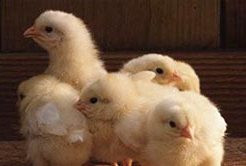
|
Original Research, A27
Uchegbu, M.C., Ogbuewu, I.P., Obimara, S.O. and Obua, B.E.
Online J. Anim. Feed Res., 1(5): 171-175, 2011.
ABSTRACT: The effects of replacement of maize with cassava root meal fortified with palm oil on performance of starter broilers were determined in a 28-day feeding trial. Five experimental broiler starter diets were formulated such that diet T1 (control) contained 60% maize. Diets T2, T3, T4 and T5 were formulated such that they contained cassava root meal (%), fortified with palm oil (%) in the proportions of 8:2, 16:4, 24:6 and 32:8 respectively, in replacement of maize. The diets were fed to broilers in a completely randomized design experiment replicated thrice. Each replicate contained 10 birds. Birds fed T2, T3 and T4 diets had statistically (P>0.05) similar daily feed intake and daily weight gain values with the control group except T5 birds that had significantly (P<0.05) lower daily feed intake and daily weight gain. Feed conversion ratios of the birds on cassava root meal and palm oil diets compared favourably with the control except for the T5 group which recorded a significantly (P<0.05) higher feed conversion ratio. The least cost (N120.95) per kg meat produced was recorded with the birds on T1 diet and followed by the T3 (16:4 %) birds. It is therefore concluded that maize as a dietary energy source in poultry diet is nutritionally superior to cassava root meal fortified with palm oil.
Keywords: Chicks, cassava root meal, palm oil, performance
|
 |
|
Can sex influence the effect of pounded Parkia Biglobosa pods on strongyle in sheep?

|
Original Research, A28
Naandam, J. and Hamidu, H.K.
Online J. Anim. Feed Res., 1(5): 176-181, 2011.
ABSTRACT: A study was conducted to examine the influence of sex on the effect of pounded dawadawa pods extract as a sequel to a preliminary work that suggested some efficacy on strongyle in sheep. The study was undertaken from September to November, 2009. Twelve Djallonke sheep (six males and six females) randomly selected were used. The pounded dawadawa pods extract was soaked (1kg pod/1.5 liter of water) and mixture was allowed to stand for 12 hours. The filtrate was administered orally at 0.5ml/kg and 0.6ml/kg body weight and a control. Faecal samples were taken from the experimental animals 72 hours after each administration. Laboratory analysis was run to identify strongyle ova after which counts were made. Experimental animals were blocked by sex. Ova counts of strongyle were found to have reduced significantly (P<0.01) over the study period for both dosages. However, the 0.6ml/kg body weight gave better results in worm ova counts, producing 97% reduction in ova counts as against 95% reduction in ova counts for 0.5ml/kg dosage. Control animals recorded an increase in ova counts throughout the study period. Worm ova counts were tended to be higher in females compared to that of males for both dosages. The trend was not evident in the control, suggesting some probable confounding effect of sex on the ability of dawadawa pods extracts to act efficaciously.
Keywords: Dawadawa pods extract, sex, sheep, strongyle, worm ova counts
|

|
|
Hematobiochemical dynamics and body weight gain of Black Bengal goat following urea molasses block (UMB) supplementation
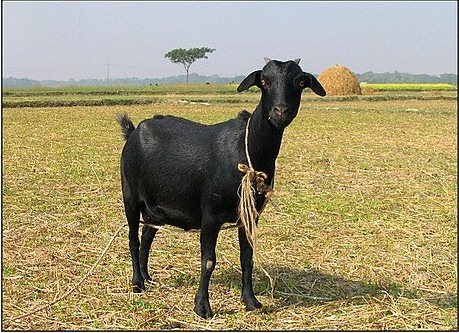
|
Original Research, A29
Hossain, F.M.A.; Hasnath, M.R and Kabir, M.S.
Online J. Anim. Feed Res., 1(5): 182-185, 2011.
ABSTRACT: Black Bengal goats supplemented with urea molasses block (UMB) resulted in body weight gain and significantly increased (P<0.05) in various hematobiochemical parameters like total erythrocyte count, packed cell volume, hemoglobin concentration, serum glutamic oxaloacetic transaminase (SGOT) and serum glutamic pyruvic transaminase (SGPT) level as compared to controlled group; whereas, erythrocyte sedimentation rate was not varied in either group.
Keywords: Black Bengal goat, body weight gain, hematobiochemical, UMB.
|
 |
|
Study on reproductive traits of two breeds of parent stock (female breeders) in the humid zone of Nigeria.

|
Original Research, A30
Olawumi, S.O. and Salako, A.E.
Online J. Anim. Feed Res., 1(5): 186-189, 2011.
ABSTRACT: This study was carried out to assess the reproductive traits of White Plymouth Rock (WPR) and Barred Plymouth Rock (BPR) parent stock reared under similar housing, management and agro-climatic conditions and the traits considered are fertility and hatchability. Total fertile eggs produced by WPR and BPR are 1,763,322 eggs and 1,732,966 eggs respectively during the observed period (2002-2005). The analyzed data showed that breed has no significant (P>0.05) effect on fertility regardless of the batch of breeder hens. WPR and BPR genotypes recorded 3.84+0.04 eggs and 3.80+0.04 eggs/hen/week respectively and were similar. Batch has highly significant (P<0.01) effect on fertility regardless of breeds’ performance. Batch 1 recorded the highest mean values, intermediate in batch 2 and batch 3, being the lowest. There was highly significant (P<0.01) effect of breed on hatchability in layer breeders. BPR genotype recorded the highest mean values in hatchability and was superior to WPR. Similarly, batch has highly significant (P<0.01) effect on hatchability. Batch 1 recorded the highest mean values, intermediate in batch 2 and batch 3, being the lowest. The batch effect implies that reproductive efficiency of breeding stock declines with advancing age. It was revealed in this study that BPR genotype was superior in terms of hatchability rate to WPR. There was no significant (P>0.05) breed x batch interaction effects on fertility and hatchability. It was indicated in this study that both genetic and non-genetic factors affected the reproductive traits of parent stock in Nigeria. Important interventions to meet the increasing demand for commercial chicks in this country include favorable environment, adequate nutrition and a more productive breed of parent stock.
Key words: Genotype, hen, chick, fertility, hatchability.
|
 |
|
Studies on the physical characteristics of some feed ingredients in Nigeria 1: Protein sources and industrial by-products.
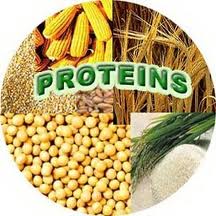
|
Original Research, A31
Omede, A.A., Okoli, I.C. and Uchegbu, M.C.
Online J. Anim. Feed Res., 1(5): 190-197, 2011.
Abstract: Physical characteristics such as particle size (PS), bulk density (BD), water holding capacity (WHC) and specific gravity (SG) of eight feed raw materials grouped into protein sources (groundnut cake (GNC), soybean meal (SBM), foreign fishmeal (FFM) and local fishmeal (LFM)) and industrial by-products (wheat offal (WO), brewers’ dried grains (BDG), palm kernel cake (PKC) and rice husk (RH)) were studied. The effects of different PS (unmodified, ≥ 1.00 mm and < 1.00 mm) on BD, WHC and SG of the experimental materials were studied using a Randomized Completely Block Design (RCBD). Particle size effect was significant for BD, WHC and SG characteristics of the feed ingredients studied. SBM and PKC consistently recorded higher BD values across PS than other feed raw materials in their individual groups. Among the protein sources, decreasing the particle size, (≥ 1.00 mm and < 1.00 mm) increased the BD values of GNC and SBM and then FFM and LFM respectively. SBM proved to hold more water than the other protein feedstuffs across all PS. At < 1.00 mm PS, RH had the lowest capacity to absorb water. Again, GNC and SBM SG values increased at ≥ 1.00 mm PS and subsequently decreased at < 1.00 mm PS. FFM and LFM also had increased SG value up to the < 1.00 mm PS. Industrial by-products (WO, BDG, PKC and RH) did not follow similar pattern in their PS-SG effects. Type of machines used and processing methods applied on these industrial by-products may be an explanation to that observation.
Keywords: Groundnut cake; soybean meal; rice husk; palm kernel cake; particle size; water holding capacity; bulk density; Specific gravity.
|

|
|
Studies on the physical characteristics of some feed ingredients in Nigeria 2: Energy source and novel feedstuffs.
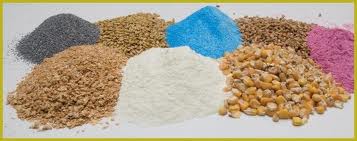
|
Original Research, A32
Omede, A.A., Okoli, I.C. and Uchegbu, M.C.
Online J. Anim. Feed Res., 1(5): 198-204, 2011.
Abstract: Physical characteristics such as particle size (PS), bulk density (BD), water holding capacity (WHC) and specific gravity (SG) of six (6) feed raw materials energy sources (maize (MZ), sorghum (SGH) and cassava flour (CF)) and novel feedstuffs (leaf meal from Microdesmis puberula (LEM), poultry dung (PD) and rumen digesta (RD)) were also studied. The effects of different PS (unmodified, ≥ 1.00 mm and < 1.00 mm) on BD, WHC and SG of the experimental materials were studied using a Randomized Completely Block Design (RCBD). Particle size effect was significant for BD, WHC and SG characteristics of the feed ingredients studied. SGH and PD consistently recorded higher BD values across PS than other feed ingredients in their individual groups. In the energy group, SGH, CF and MZ had the highest WHC at unmodified, ≥ 1.00 mm and < 1.00 mm PS respectively. The WHC value of the LEM (5.50 g water/g feed) used in this study was twice higher than values for PD and RD at the < 1.00 mm PS suggesting the possibility of a high content of soluble non-starch polysaccharides. Energy group (MZ, SGH, and CF) had reduced SG values as the PS was modified from ≥ 1.00 mm to < 1.00 mm PS. The physical characteristics of feed ingredients studied cannot be concluded to be optimal since the standard values for the country do not exist.
Keywords: Maize; sorghum; poultry dung; rumen digesta; particle size; water holding capacity; bulk density; specific gravity.
|

|
|
A molecular (PCR) survey on abortions caused by Campylobacter spp. in the dairy cattle of Tabriz-Iran.
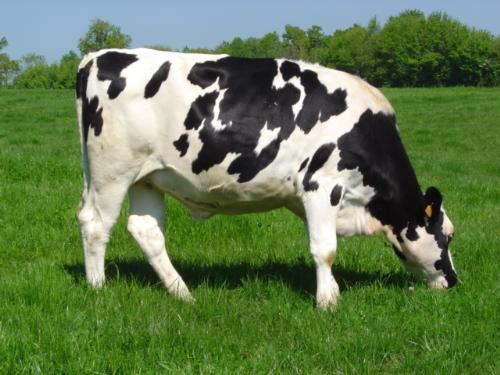
|
Original Research, A33
Hamali, H., Nofouzi, K., Jafari, R.
Online J. Anim. Feed Res., 1(5): 205-208, 2011.
ABSTRACT: This study was conducted to determine the prevalence of Campylobacter spp. induced abortions in Tabriz (northwest Iran) dairy herds and also to determine the pathogenic species responsible. A total number of 76 aborted fetuses and related placentas were admitted to the large animal clinic at the University of Tabriz, from May 2008 to August 2010. Tissue samples were collected from several fetal organs including liver, kidney, lung, spleen, heart, stomach fluid and placenta, then separately pulverized under liquid nitrogen and finally stored at -20°C until DNA extraction. DNA extraction from frozen tissues samples was performed using a commercial kit (AccuPrep Genomic DNA Extraction Kit, Bioneer, S. Korea) following the manufacturer’s instructions. Of 76 submissions (fetuses, placentas), 3 (3.9%) sample were diagnosed positive to the Campylobacter fetus subsp. Veneralis by the PCR protocol. This is the first report on abortion caused by Campylobacter fetus subsp. Veneralis from the dairy herds of Tabriz-Iran.
Keywords: Campylobacteriosis, abortion, cattle, PCR, Tabriz
|

|
|
Effects of feeding different levels of Balanites aegyptiaca (HEGLIG) kernel cake on cattle rumen environment.
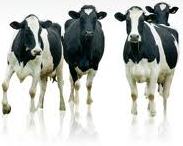
|
Original Research, A34
Morkaz, M.G., Elamin, K.M., Ahmed, S.H. and Omer, S.A.
Online J. Anim. Feed Res., 1(5): 209-213, 2011.
ABSTRACT: The present experiment aimed to investigate the effects of replacing groundnut cake with Balanites aegyptiaca kernel cake up to 15% on rumen environment in local kenana cattle. The study was conducted at the experimental unit of Veterinary Medicine and Animal Production College, Sudan University of Science and technology at Hillat Kuku. Traits studied were rumen pH ammonia concentration (NH3), volatile fatty acids concentration (VFAs) and bacterial count (BC). No significance difference was observed for pH, NH3, VFAs and BC between treatments. Generally, NH3 and VFAs was increased with time post feeding. But, BC decreased with time post feeding. It was concluded that incorporation of B. Aegyptiacua kernel cake at 5, 10, 15% to replace equal percentages of groundnut cake did not significantly (P<0.05) affected rumen environment.
Key words: Ammonia, Bacteria Balanites aegyptiaca, Cake
|

|
|
Prevalence of poultry disease and parasites in Botswana.
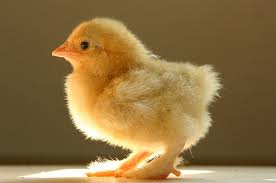
|
Original Review, A35
Moreki, J.C., Chiripasi, S.C., Montsho, T., Chibua, R. and Gabanakgosi, K.
Online J. Anim. Feed Res., 1(5): 214-217, 2011.
ABSTRACT: This paper reviewed literature on the prevalence of diseases and parasites of poultry in Botswana over a five year period, i.e., from 2006 to 2010. Coccidiosis was the most prevalent disease in poultry species except for ostriches which were mainly affected by colisepticaemia. The highest prevalence of diseases and parasites was recorded in 2007 with fowl pox, coccidiosis, salmonellosis and helminthiasis being the main contributors. Fowl pox was prevalent in family chickens which are reared under free range. Poultry diseases were mainly prevalent in Gaborone, Mochudi, Francistown and Molepolole districts with 225, 168, 148 and 135 cases, respectively. Newcastle disease was sporadic throughout the study period. In the present study, the common parasites of poultry were mites, fleas, lice, ticks and helminths, and helminths were the most prevalent followed by mites. Of all species, chickens were affected most by parasites followed by guinea fowl. These results suggest inadequacies in health management, indicating that strict biosecurity measures should be put in place in order to reduce mortalities. There is also a need for extension service to train farmers on health management.
Key words: Biosecurity, coccidiosis, diseases, Newcastle disease, parasites, salmonellosis
|

|
|
Morphometric traits as indicators for body weight in Sudanese Kenana cattle.
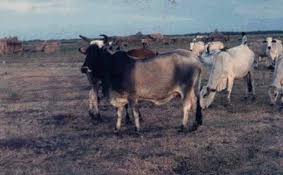
|
Original Research, A36
Musa, A.M., Elamin, K.M., Mohammed, S.A. and Abdalla, H.O.
Online J. Anim. Feed Res., 1(5): 218-222, 2011.
ABSTRACT: In this study body weight in both sexes was predicted using some morphometric. Traits used were height at withers (HTW), heart girth circumference (HGC), abdominal girth circumference (ABGC) and body length (BL). The overall means of live body weight (WT) and of the studied morphometric traits (HGC, ABGC, BL and HTW), respectively, were 281.814 ± 3.527kg, 150.641 ± 0.447, 190.542 ± 1.177, 87.963 ± 0.512 and 119.023 ± 0.497 cm. The phenotypic correlation coefficients for body weight (BW) with HGC, ABGC, BL and HTW in this experiment were 0.98, 0.78, 0.64 and 0.70 respectively. Prediction equations were obtained for combined sex, males and females. R2 was high in the three equations (0.97, 0.98 and 0.97 respectively). Obtained prediction equations were tested for their validity by estimating body weights of six males and 25 female kenana cattle. These animals were weighed by three different methods; the equations, Dalton tape and large ruminant scale, and obtained weights were not significantly different (P ≤ 0.05). It was concluded that prediction equations can be used efficiently to estimate live weight in Kenena cattle when it is difficult to use scales.
Keywords: Body weight, correlations, Kenana cattle, morphometric traits, Sudan
|

|
|
Survey of chemical disinfectants used by poultry farmers in Imo state, Nigeria.
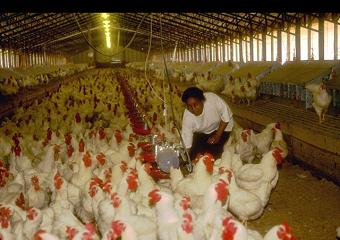
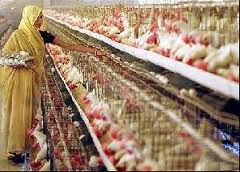
|
Original Research, A37
Chima, I.U., Uchegbu, M.C., Okoli, I.C. and Okoli, C.G.
Online J. Anim. Feed Res., 1(5): 223-230, 2011.
ABSTRACT: Pathogen contamination can be prevented with aid of proper health care products such as disinfectants. This study was designed to evaluate the efficacy of common disinfectants and disinfection practice of poultry farmers in Imo State, Nigeria, in order to generate information needed for the proper regulation of disinfectant use in the area. Primary data were generated from structured questionnaires distributed to animal health practitioners and poultry farmers in the State. Results showed that farmers choice of disinfectants were dependent on cost and availability. Z-germicide® 10 (22.27%) and Izal® with 9 (20.45%) are more widely distributed in the various animal health outfits. This was closely followed by Lysol® 6 (13.63%) and Diskol® 6 (13.63%). Morigard® 3 (6.81%), Dettol® and Septol® 3 (6.81%) appeared each in three outfits. Vox® 1 (2.27%) CID 20® 1 (2.27%) a Virkon® 1 (2.27%) occurred once and that is at the Avian influenza desk officer’s store. Izal® 140 (58.82) was more widely used by farmers followed by Z-germicide®, both of which are phenolic products. Morigad® with 2 (2.94%) and Lysol® with 91.47%0 are also phenolic products. Altogether 76.47% of disinfectants used in Imo State were of phenolic products. Most poultry farms in the State did not use disinfectant footbath. Those that used them did not insist on workers or visitors dipping their feet in them before entering the farm house. They also did not reconstitute the disinfectants according to the manufacturer’s instructions.
Keywords: Disinfectants, poultry farms, disease, Nigeria
|

|
|
Effect of environmental factors on body condition score of Taggar goats under dry land farming in western Sudan
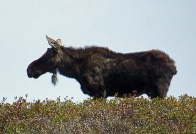
|
Original Research, A38
Bushara I., Abdelhadi, O.M.A., Elemam, M.B., Idris, A.O. and Abu Nikhiala, A.M.
Online J. Anim. Feed Res., 1(5): 231-234, 2011.
ABSTRACT: Effects of type of supplementation, season of kidding and litter size on body condition score (BCS) at kidding and at weaning time were evaluated in Taggar goats in extensive management under dry land farm. The supplemented groups (2 and 3) had (P<0.05) higher body condition at kidding compared with the control group. Body condition at time of weaning was sharply decreased, but the decline was greatest in control groups. The rainy season kidders showed higher (P<0.05) BCS at kidding and at weaning time compared with dry season kidders. Twin kidders had a tendency (P>0.05) for higher BCS at kidding compared with single and triplet kidders. At weaning time triplets kidder had slightly lower (P<0.05) body condition compared to single and twin kidders.
Key words: Tropical, supplementation feeds, productivity, Dalanj, Taggar, Sudan.
|

|
|
Effect of feeding different levels of decorticated sun flower cake (Abad Alshames) (Helianthus nnuus L.) on performance of Sudan desert goats.

|
Original Research, A39
Hassan, H.E., Elamin, K.M., Tameem Eldar, A.A. and Arabi, O.H.
Online J. Anim. Feed Res., 1(5): 235-238, 2011.
ABSTRACT: This experiment was conducted to study the effects of replacing groundnut cake with sunflower cake in ruminants feed. The replacement was done at three levels, 0%, 15% and 25%, which were incorporated in three isocaloric, isonitrogenous diets A, B, and C, respectively. Nine male kids of Sudan desert goats at 3-4 months of age and average body weight 18.14 kg wee used in this experiment. The kids were randomly assigned to three treatments (3 animals each), then the animals in each treatment was subdivided into three groups of one animal (replicates). The study showed a significant difference (P<0.05) between treatments for average daily weight gain (ADG) and feed conversion rate (FCR), on the other hand, the study showed that there was no significant difference (P>0.05) between treatments for average feed intake, average final body weight gain and average of total gain. According to the results, sunflower cakes meal had no deleterious effects on ruminant’s performance; it may be used up to 25% in kids feeding with satisfactory results. Also sunflower cakes meal could be used for growing kids and fattening of mature goats.
Keywords: Abad Alshames. Body weight, Kids, Feed conversion, Nubian
|

|
|
Epidemiology of Helminth Parasites in Small Ruminants of Ladakh, India.
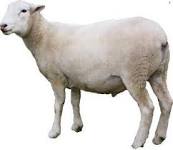
|
Original Research, A40
Kuchai, J.A. Chishti, M.Z. Zaki, M.M., Ahmad, J. Rasool, M., Dar, S.A., and Tak, H. Online J. Anim. Feed Res., 1(5):239-242, 2011.
ABSTRACT: A study was conducted to determine the prevalence and various risk factors associated with helminth parasitism in small ruminants of Ladakh (India) during 2007-2008. A total of 581 small ruminants including 313 sheep and 268 goats were considered during the study. The gastrointestinal tracts including heart and lungs of the host animals were collected from different slaughtered houses and were subjected for the presence of larvae and adult helminth parasites using standard parasitological methods. The study reveals overall prevalence as (69.70%) with (68.37%) and (71.26%) in sheep and goats respectively. A significant difference was observed in prevalence of helminth parasites with respect to season, wherein higher prevalence (76.50%) was observed during the wet season as compared to dry season 58.13%. Similarly an association was observed between sex and age of the host with prevalence of helminth infections. Females and young animals of either of the host species were more infected than their counter partners. Likewise an association was observed between prevalence and agro-ecology of the study area where in higher values (76.50%) were recorded for comparatively lowland (Kargil) areas as compared to highland (Leh) areas (58.13%). Hence, it was concluded that species of the animal, season, sex, age, and agro-ecology are important risk factors associated with helminth parasitism in this area.
Keywords: Sheep, Goats, Helminth parasite, Prevalence, Ladakh
|

|
|
|
|
|